Game birds, such as Turkeys and Guinea Fowl, are a wonderful addition to many homesteads and farms. They can be raised for meat or eggs and are an effective form of pest control when free-ranging and given the opportunity to forage for bugs. In this blog post, we explore the various breeds of turkeys and guinea fowl that we carry and discuss how to decide which one is right for you. For details on how to place your order, visit our 2021 Chick Season Guide.
Guinea Fowl
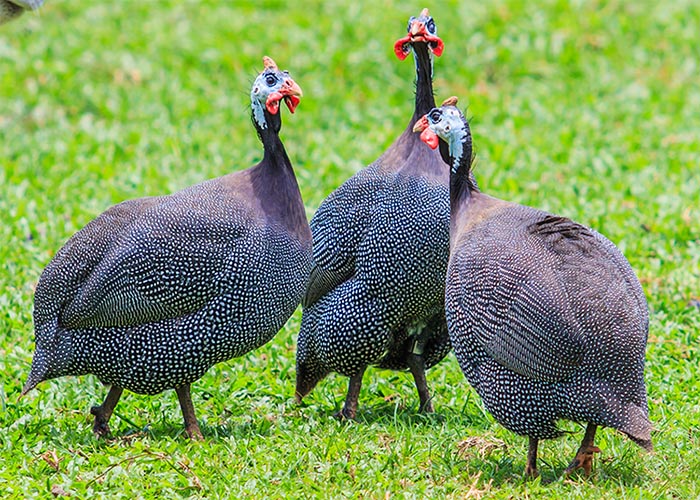
Originally from the African Sahara, Guinea Fowl were brought to America before the 1850s. The French Pearl Grey Guinea is the most common variety of guinea sold; they have a dark grey or black plumage with tiny white specks. The Coral Blue Guinea is one of the only poultry colors said to be actually blue; they have a dark coral blue shade to their neck, breast, and back. Lavender Guineas are a light blue with dark blue stripes and markings. When fully grown, Pied Guineas have white on the chest, wings, and, sometimes, the back area; we sell an assortment of pied guineas including, purple, pearl, chocolate, buff, and other colors.
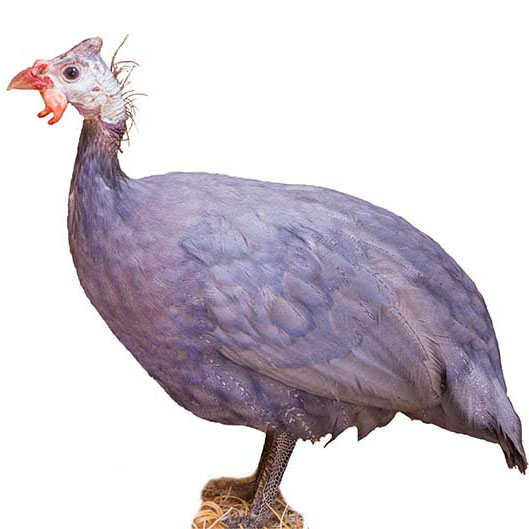
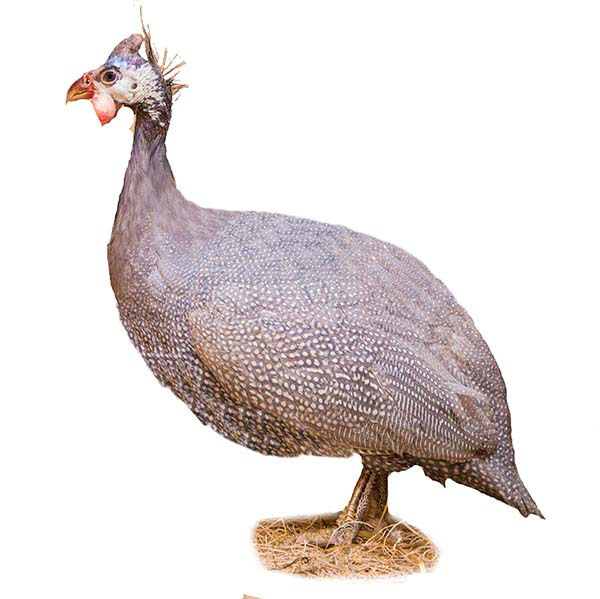
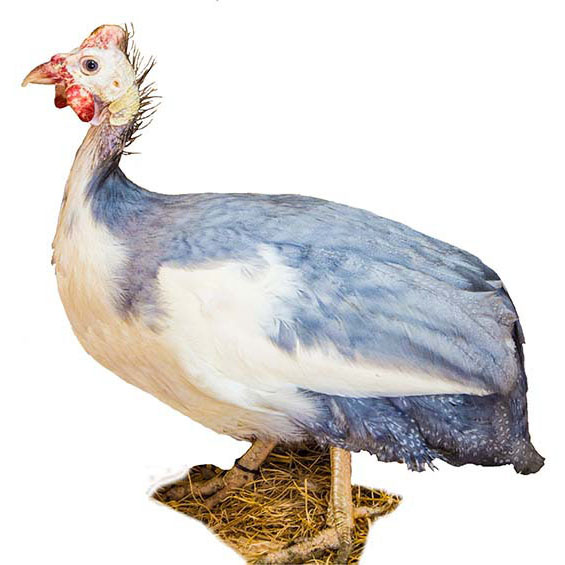
All above photos courtesy of Guinea Farm in New Vienna, Iowa
Guineas are striking, entertaining birds that make the best watchdogs for your farm or backyard but can also be used for market or eggs. If raised for meat. they are processed at 12 weeks and generally weigh around 4 lb. There is a demand for their lean, tender, dark meat at certain restaurants.
Guinea hens lay about 135 eggs each year, but, if you plan to collect them, the birds will need to be in confinement. They prefer to lay their eggs in the bushes or woods, rather than nest boxes. They are good setters, but once the keets are born, the hens are often off and running. They do not care for and protect their young like chickens.
The birds have larger-than-life personalities and will raise a whole lot of racket if anything foreign comes near the property. Guinea fowl are exceptionally loud and territorial and tend to be highly reactive to visitors so they are excellent watchdogs.. They generally do not chase caretakers as roosters do, but they do like to follow you around, especially if you offer treats or mealworms.
Guinea fowl are not known for being overly docile or friendly, but with a generous amount of handling when they are younger, they will be easier to manage. They move and run fast so can be difficult to catch, especially because they fly well and will instinctively roost in trees. It is important to coop-train them at an early age. Guineas live well with chickens but are very dominant and will run the coop. They are low-maintenance birds since they prefer to forage and eat grubs and bugs. They can roam a long ways and can fly high and long distances around your property.
Guineas are also one of the best domestic foragers for ticks and grubs. They can help keep your property clear of most insects and even small rodents. Many farms that have introduced them to help with tick control have seen a decrease in tick bites or engorged ticks on their animals and family members. They are excellent forms of pest control and can be a large help
around homestead operations. Guineas are also great gardeners. They do not uproot plants or scratch the soil while foraging for insects. They truly are an asset for many farms and fun to care for as well.
Turkeys
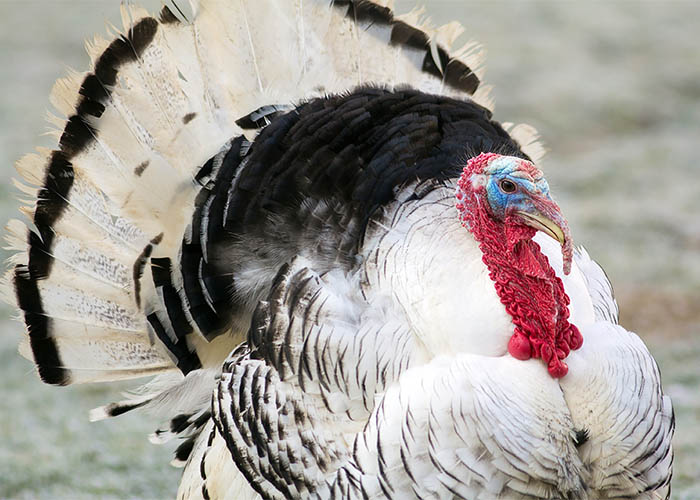
Fun to watch and raise, turkeys are highly prized for their delicious meat. They can be a profitable addition to your homestead, with many breeds reaching market weight in 16-22 weeks. Turkeys are also highly entertaining and make great pets!
Blue Slate Turkeys
The Blue Slate Turkey is a rare heritage breed fowl; it was first recognized as a standard breed in the United States in 1874. They are named for their ash blue coloring and are sometimes referred to as Lavender turkeys. The blue gene can produce several colors: solid black, solid blue, and blue flecked with black spots; often Blue Slates are a combination of these colors. Hens tend to be lighter in coloring than toms. These beautiful birds are medium-sized: young toms will average 23 lb and young hens will average 14 lb.
Bourbon Red Turkeys

Originally from Bourbon County, KY, the Bourbon Red is a breed of a domestic turkey named for its unique reddish plumage. The bird’s feathers are a dark chestnut base color, with white tails and flight feathers. It was selectively bred for utility traits as a meat bird and was an important variety in the turkey industry throughout the 1930s and 1940s. Like most turkey breeds, its popularity declined after this point with the commercial adoption of the Broad Breasted White. Populations began to recover in the early 21st century, and today it is one of the most popular heritage turkey breeds in the United States. Despite its relative popularity as a heritage breed, it is still listed as being “watched” by the American Livestock Breeds Conservancy, because there are fewer than 5,000 breeding birds in the States. Mature Bourbon Red toms weigh in at 33 lb, and mature hens weigh about 18 lb.
Broad Breasted Bronze Turkey
The original Bronze turkey was the most popular turkey variety for most of American history. It originated from crosses between the domestic turkeys brought by European colonists to the Americas and the Eastern wild turkeys they found upon their arrival. In the early 1900s, a broader breasted Bronze turkey was introduced from England into Canada, and then into the northwestern United States. These were crossed with larger, faster-growing American turkeys and the resulting bird, the Broad Breasted Bronze, became the commercial variety of choice.
At the same time, changes in conformation (especially the shortening of the legs and the keel) nearly eliminated their ability to mate naturally. For this reason, most Broad Breasted Bronze turkeys have been artificially inseminated since the 1960s. The Broad Breasted Bronze turkey is considered by some to be the largest and heaviest of the turkey variety. At 20 weeks of age, hens weigh around 21 lb and toms weigh about 29 lb. Some people prefer the white version of this bird, the Broad Breasted White Turkey, for a nicer finished table product. This is due to the pin feathers being less visible on a white-feathered bird. Either way, they are large hearty birds that will feed the whole family.
Broad Breasted White Turkeys
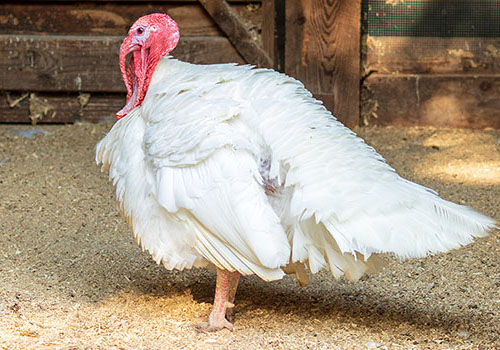
For a time, the Broad Breasted Bronze Turkey held the dominant position on the turkey market, but, beginning in the 1960s, meat processors began to prefer the Broad Breasted White turkeys because they produced a cleaner-looking carcass. Because their feathers are all white, their pin feathers are not visible when the bird is dressed. Broad Breasted White Turkey poults are an excellent choice if you want to raise a turkey for meat. The Broad Breasted White Turkey is the breed raised by commercial turkey farmers in the United States and they are the turkeys currently sold in grocery stores. It is the best choice for those who enjoy breast meat.
These birds have shorter breast bones and legs than other breeds, which makes them unable to reproduce naturally. They must be artificially inseminated. If you are interested in breeding turkeys, we suggest heritage breeds instead.
The large size of the Broad Breasted White Turkey has some advantages and disadvantages associated with it. The birds have been bred to grow large; some of them exceed 50 lb at full maturity. However, some people feel that taste and texture have been sacrificed for size. If you want to raise a bird that tastes similar to those you can purchase in the grocery store, this is the breed for you.
Chocolate Turkeys
Before the Civil War, Chocolate Turkeys were common in the Southern United States and France. Then, large numbers of breeders were lost and the entire population dwindled to just 12 birds before they were able to make a comeback. Due to the lack of breeding birds at the time, most Chocolate turkeys today are not pure and are carriers of Bronze and Narragansett genes; some may carry Bourbon Red as well. Their name Chocolate describes the color of its feathers, shanks, and feet, which are a solid milk chocolate color in adult birds. Chocolates are one of the largest heritage turkey varieties and are known to be very gentle. These turkeys are good mothers and chicks are born with cocoa-colored bodies and white heads. The meat is flavorful, but not all that different from your average turkey. Chocolates do produce more meat than some other heritage varieties, due to their large size. The mature weight of toms is approximately 33 lb and the mature weight of hens is about 18 lb. Chocolate Turkeys are still critically endangered.
Royal Palm Turkey
The Royal Palm Turkey is a domestic breed that has been in the United States since the 1920s. One of the few turkeys not primarily selected for meat production, the Royal Palm is best known as an ornamental bird with a very unique appearance. Primarily kept as an exhibition bird, or on small backyard farms, they lack the size for large-scale commercial use. Toms usually weigh 16-22 lb and the hens weigh 10-12 lb. The toms are noted for being non-aggressive and the hens are particularly good mothers. Royal Palms are an endangered breed today. The American Livestock Breeds Conservancy categorizes the breed as critical on its watchlist, the highest priority of conservation. If you are interested in turkeys but are looking for a smaller-sized bird, consider helping to preserve this beautiful variety and start your own flock with our Royal Palm poults.
At The Cheshire Horse, we carry everything you need to properly care for your turkeys and guinea fowl. If you have any questions regarding the poultry breeds that we carry or would like assistance choosing the right breed for your farm, we encourage you to reach out to a member of our friendly and knowledgeable sales staff.

Amazing!